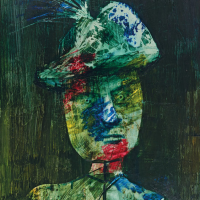20. SIDNEY NOLAN

Sidney Nolan was closely in tune with Australian life. Although he lived away from Australia for much of his career, the history of his birth country continued to be the wellspring of his art. Nolan was intent on finding suitable metaphors and myths for a young country still finding its identity. The paradox of the Anzac legend fascinated Nolan a celebration of military withdrawal and defeat in World War I, viewed by many as an event that also marked Australias coming of age.
Head (from the Gallipoli series), dated verso, 27 December 1958, belongs to the first rank of large-scale paintings on this subject that Sidney Nolan produced over two years in 1958-59. Sidney and his wife Cynthia were living in New York at the time; however, the origins of this important series hark back to 1955 when they were staying on the Greek Island of Hydra. According to curator Jane Clarks classic text on the artist, the Nolans moved into a beautiful, two-hundred-year-old house on Hydra where Nolans interest in ancient Troy and texts such as Homers Iliad came to the fore. A propitious meeting with expatriate Australian writer and journalist Alan Moorehead, on a neighbouring Greek island, set in train an expansion of Nolans interest in the Anzac legend. Moorehead was working on a book about Gallipoli and had written an article on the Australian offensive of April 1915 fought over the same territory as the Trojan War.1
In the spring of 1956, Nolan spent time at Gallipoli, walking in the steps of the Anzac soldiers and the ancient Greeks before them. He commenced the first artworks on the theme; small works on paper that deftly recorded soldiers writhing in the water or struggling up the sheer cliffs. These first gestations eventually led to the larger paintings such as his Gallipoli Heads.
In the Gallipoli series, Anzac soldiers are invariably shown face-on, from the shoulders up, wearing uniforms and hats that signify their rank. Some of these heads are based on portraits of people that Nolan knew well. One is loosely based on a young Arthur Boyd, for example, someone who Nolan remembered appeared out of place in a uniform, projecting an innocent yet knowing look.2 Another is a portrait of a soldier wearing a plumed hat and tunic, thought to bear a resemblance to Nolan's friend Kenneth von Bibra, who was killed in Syria in the Second World War. Nolan had lost his brother, Raymond, who had drowned in a tragic accident in Cooktown after returning from military service. His untimely death and that of so many other young Australian men became permanently etched on Nolans mind.
Head is an imaginative attempt to describe the horrors of war on the innocence of youth. The slouch hat with emu plume identifies the figure as a member of a calvary brigade, the Light Horseman, whose ranks were filled with fresh-faced country lads, made famous in the lines of a Banjo Paterson poem: Hes cavalry to travel but hes infantry to shoot. And youll know him by the feathers in his hat.3 These soldiers were eager to serve their country well, though the reality they faced proved far more challenging than what they had been led to believe.
Nolan empathised with the nigh-impossible task faced by our Gallipoli soldiers. His paintings confront the viewer with the soldiers head-on positioning and glazed vacant eyes, recalling a 1942 painting by Nolan of a shell-shocked soldier that appeared on the cover of Reg Ellerys Psychiatric Aspects of Modern Warfare, 1945. The watery film of polyvinyl acetate used in this Anzac Head painting further coats the figure in a nebulous cloak of darkness and uncertainty. As Nolan himself commented, All these people, all these heroes exist in a kind of dream, larger than life 4
Footnotes
1. Alan Moorehead, quoted in Clark, J., Sidney Nolan: Landscapes and Legends, National Gallery of Victoria, Melbourne, 1987, p.129
2. February 1982, reproduced by the Australian War Memorial, Canberra (accessed October 2022): https://www.awm.gov.au/collection/C172918
3. Paterson, B., Queensland Mounted Infantry, 1900, reproduced by All Poetry (accessed October 2022): https://allpoetry.com/Queensland-Mounted-Infantry
4. Sidney Nolan in an interview with Noel Barber, 1964, quoted in Clark, J., op. cit., p.131
Rodney James
Rodney James is an independent art consultant who specialises in valuations, collection management, exhibitions, research and writing, and strategic planning for art galleries and museums.